By Shohei Kurita
The copyright is reserved.
Mt.Fuji Brings Rich Clean Water Springs
Mishima City with population of 110,000 is situated in the place of real
gateway of Middle Izu and West Coast provinces, and is full of historical
monuments of Kamakura Era and Edo Era. Visitors can see one of the most
beautiful and elegantest shape of Mt.Fuji in this country, anywhere in
the city, when the weather condition is fine (See Figure 2).
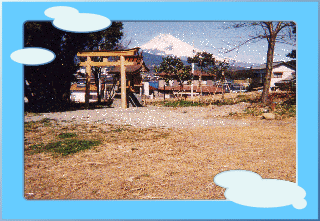 |
|
| Figure2 A view of Mt.Fuji@rom a dwelling ward on a hill in the northern district of Mishima City. |
The highest mountain in Japan of 3,478 meters high has brought huge natural
benefactions both to the dwellers of Mishima City and ones of the nabouring
cities and towns as Numazu City, Susono City,Shimizucho Town, Nirayamacho
Town, Kannamicho Town,etc. One of the benefactions is its many clean water
springs here and there in the city. In Shimizucho Town nabouring Mishima
City, there is Kakitagawa River Springs Group gushing out the richest quantity
of clean water in Japan, which yields one million tons of clean water a
day.
Map of Mishima City
JR's Tokaido Line forms boundary between northern district and southern
district of Mishima City. The northern district includes educational area
in which Nippon Universty's College of International Relations and the
universty's Mishima Senior High School,Public Northern Senior High School
run by Shizuoka Prefecture and public Northern Junior High School by the
city,central governmental branch offices stand abreast, and is stretched
by residence quarter towards the bottom of Mt.Fuji and Hakone mountaineous
area(See Figure 3). Nippon Universty's College of International Relations operates Department
of International Relations, Department of Intercultural Relations, Department
of Global Exchange Studies, Department of International Business and Information.
The southern district is full of historical monuments such as Mishima Taisha
Shrine,the old site of Daikan's (Representative Official's) House of Tokugawa
Shogunate (Government) acted by Egawa Family,the old site of Izu Kokubumji
Temple in the ancient Nara Era, Hokyoin Temple having the toumb of Yoshiakira
Ashikaga,Shogun the Second of Ashikaga Shogunate,etc. Hokyoin Temple is
situated in the right
part which is not drown on Figure 3 along the roard before Mishima
Taisya Shrine.
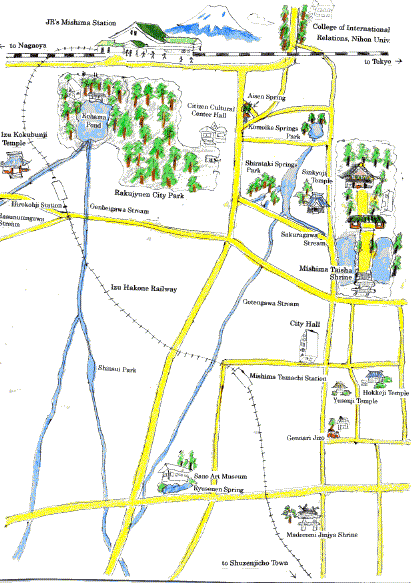 |
| Figure 3 Southern disitrict of Mishima City is full of historical monuments. |
Mishima Taisha Shrine, The Origine of Kamakura Hachimanguh Shrine
Mishima Taisha Shrine is one of the biggest and oldest shrine with history
of thousand and several hundred years in this country. About 800 years
ago, Yoritomo Minamoto praied for victory of his war against Heike (Taira
Clan) by coming to Mishima Taisha Shrine every dawn for consecutive a hundred
days, prior to the outbreak of the war. In it's premises there are two
stones on which he and his wife, Masako Hojyo often sitted to rest for
a while.
Mishima Taisha Shrine is the origine of Tsurugaoka Hachimamguh Shrine in
Kamakura City which you can see it today. Its first building was completed
at Tsurugaoka near the present building by his ancestor Yoriyoshi in AD
1063, and then Yoritomo moved and reassembled it to the present place in
1180 after he made victory, but unfortunately this old shrine was burnt
down by fire. In 1191 Yoritomo reconstructed the present magnificent shrine
as Genji Clan's protecting deity by imitating the arrangement of the premises
of Mishima Taisha Shrine with two ponds and two open spaces.
Mishima Taisha Shrine was also burnt several times by big fires or an earthquake
and the present main shrine was rebuilt as an all zelkova wood made hall
of worship more than 130 years ago in Meiji Era by Mr.Yatabe, the guardian
of the shrine who made fund raising successfully(See Figure 4).
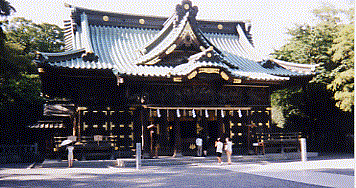 |
| Figure 4 The Hall of worshp of Mishima Taisha Shrine is all zelkova wood made. |
In its grand premises, many old and huge trees such as zelkova,camphor,
or pine trees stand stretching their branches to form comfortable shadows
in summer season. You will always see many tourists from all the places
throughout Japan and overseas as well as the citizens in the city. In spring
season, cherry trees along the road to the hall of worship are in full
blossom, making visitors bieng in an ecstacy. In the right side of the
premises, there is a deer-breeding house in which more than 30 deers are
living, because they were regarded as saint animal in ancient time.
An Old Huge Osmanthus Aurantiacus Tree of 1,200 Years of Age Emits Fragrance
to 10 Kilometers Distance in Radius
Walking through the two gateways, you will see a dedicating dancing building
and an old, huge osmanthus aurantiacus tree aging for more than 1,200 years
in the right side in front of it.. The tree which was designated as a natural
commemoration object by ministor of education still emits fragarance within
a radius of 10 kilometers (6.2 miles). The tree has seen the people coming
to worship for more than 1,200 years including Nara, Heian, Kamakura, Muromachi
Eras, the Period of War for about 100 years, Edo, Meiji, Showa Eras, and
the current Heisei Era. The tree is about 15 meters high and its branches
cover 250 square meters. In the time of the first to the second part of
September, it makes flowers of gold colour, and from the third part of
September to the first of October it blooms again. .
In the treasury, you can see many treasures including national treasures
and important cultural assets such as swords, caligraphies by Shoguns in
old eras, paintings, artistic boxes,
Yearly Grand Festival of Mishima Taisha Shrine Collects 530 Thousand Audience
in 2002
Mishima Taisha Shrine holds grand festival every year for 15th to 17th
of Augaust as same as in the period of Yoritomo was living about 800 yearas
ago.
In these three days, it holds variety of events including fancy dress parade
of Yoritomo's raising his army in armor, parade of floats by town, dancing
parade playing farmers warrior song called "Nohhei-Bushi", match
of drawing a bow by riding a horse in Samurai costume, which is called
Yabusame. for which around 10 riders of the conservation group compete
to hit the three marks being set up every several tens of meters distance
while running at full speed.on the course of 250 meters in legth. The riders
have to master both Japan's archery and horsemanship(See Figure 5-13).
Every town in the city competes by playing (called) Shagiri festival music
with drumming small metal bells for the whole three days.
In the one night, a fireworks display is held. Thus this grand festival
attracts 600 thousand visitors throughout Japan.
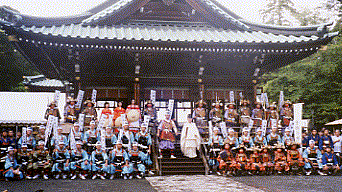 |
Figure 5 Ceremony before going to battle is held, wearing old day's armor on a day of the yearly grand fesitival on August 16, The building is dedicated dancing hall |
| Figure 6 Kohji Matoba, an young and vigorous actor (left side in the center) in movies and TV dramas was acting Yoritomo Minamoto in 2002.He was posing riding on a horce to the audience on the street. |
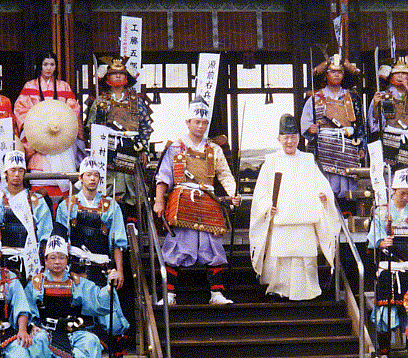 |
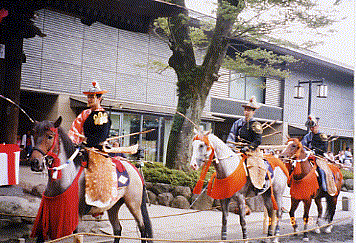 |
Figure 7 The experts of "Yabusame" are going to the cource of the match.. |
| Figure 8 "Yabusame" The match of drawing a bow by riding a horse in samurai costume is done. |
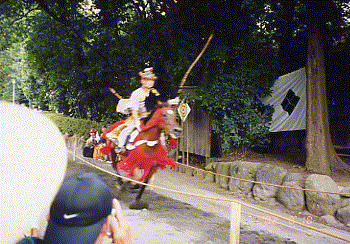 |
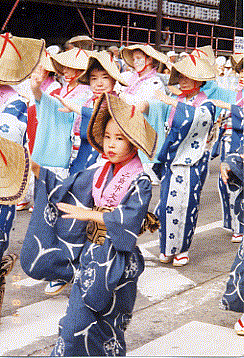 |
Figure 9 The dancing parade playing faramers warrior song called 'Nohei-Bushi' is passing on the main street. |
| Figure 10 The students of Southern Senior High School parade, playing "Nohei-Bushi" song with " samisen" (a Japanese stringed instrument). |
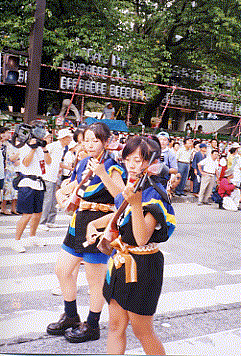 |
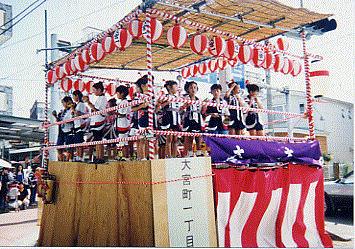 |
Figure 11 "kan,kan,kan! Kan,kan,kan!" Children in Ohmiyacho are drumming a small metal bell in their hand loudly. |
| Figure12 Men and women also compete playing "Shagiri" on their float. |
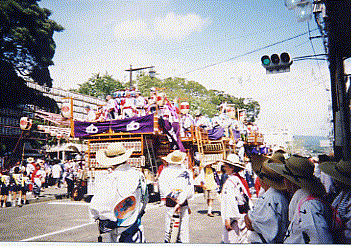 |
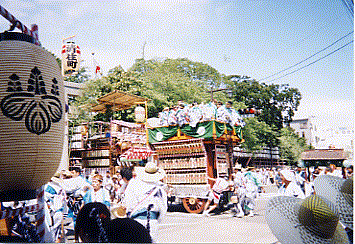 |
Figure 13 Many floats of "Shagiri" representing every town in Mishima City gather on the main road in front of the gate of the shrine for parading.. |
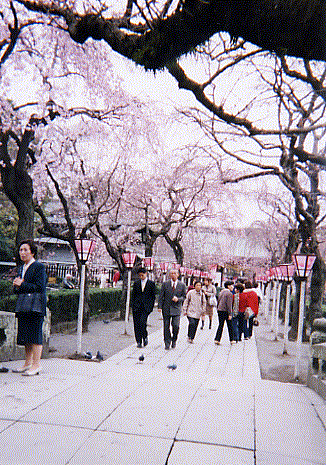 |
Figure 14 Many cherry trees on the way to the worship hall are in full blossom in spring season. |
| Figure 15 A dancing team came from Itoh City on the east coast of the peninsula plaied the dance of "Itho Dengaku Dance" passionatly in 2001 when the 400th anniversary of opening 53 towns and cities combining Tokaido Way set up by Iyeyasu Tokugawa Shogun |
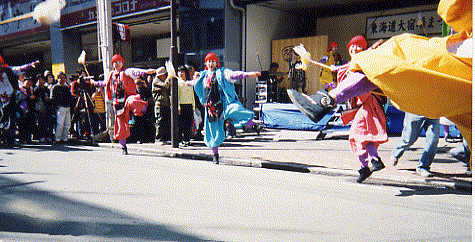 |
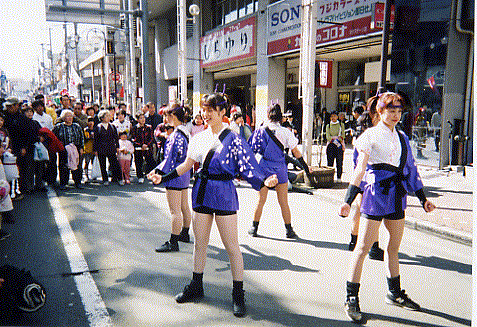 |
Figure@16 A team from Shizuoka City plaied the dance of tea plucking song called "Chakkiri-Bushi" in the same anniversary in 2001. |
Rakujuen City Park
In front of JR's Mishima Station in the southern district, there is Rakujuen City Operating Park with the space of more than 60000 square meters, in which more than 12O kinds of trees stand
stretching their branches and many kinds of birds singing and
warbling. The board written by the city's educatinal committee
explains the park as the following in short:
"Rakujuen Park is registered as a natural monument and a natural beauty
by central government. It is situated in the end of the bottom stream of
lava out of Mt.Fuji. You can see underground water springs gushing out
at several points in Kohama Pond. However, since middle of 1950s, the phenomena
of gushing springs has been suffered from the rapid development of civilizational
environment and is changing." Nowaday, visitors will see only small
quantity of water when in good condition at the bottom of the pond. Mishima
City is considering to recover the water springs.
Imperial Prince Akihito Komatsu built his villa named Rakujutei House there
112 years ago ( in 1890 ), with the fund valued \250,000 which Emperor
Meiji gave him as a bonus to his distinguished services at the time of
Meiji Restoration, when Chosyu and Satsuma feudal clans won a victory over
Tokugawa Shogunate in the end of Edo Era, Prince Komatsu headed the alliance
force of both the feudal clans. Rakujutei House was constructed as a pure
Japanese design of residence surrounded by nature. If you visit this house
either at AM10.30 or at PM1.30, you can see inside the house and observe
its design, paintings on variety of wooden doors,sliding doors,furnitures,etc.
written by the first class painters, by guidance of a staff of the park.
The house with park of nature was acquired by a millionaire after the world
war second and he donated it all to Misima City. The city operates a small
zoo in which rare animals like lesserpandas, squirrel-monkeys, a giraffe,etc.
live. You will be able to observe the local history by entering the Kyohdo
Shiryokan (Home Materials Museum) near the zoo.
Rakujuen Park is open except every monday. Its entrance fee is \300 for
adult and \100 for kid.(See Figure 17-18)
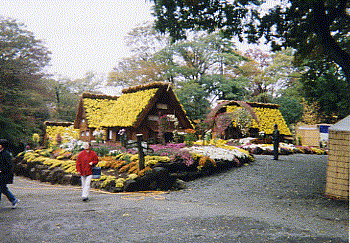 |
Figure 17 In autamn season in 2002, the models of Shirakawa farmers houses which are registered as the World Assets are decorated with full of flowers of chrysanthemum. |
| Figure 18 The sceine with colourful flowers of chrysanthemum backed by the pictures of Mt.Fuji and mountains is also one of the grand sights.. |
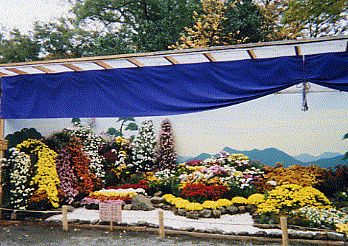
|
Genbeigawa Stream, A Revival To Nature With Fireflies Flying In Summer
Starting from Kohama Pond in Rakujyuen Park, Genbeigawa Stream which has
been reappeared nature in the environment everywhere more than fifty several
years ago by the volunteer group living in the city, fosters variety kinds
of fish such as killifish, loaches and the rare kind of duckweed called
"Mishima Bai-Ka-Mo" in Japnese. The name means "Mishima's
duckweed with white small flowers similar to those of plum tree."(See Figure 19)
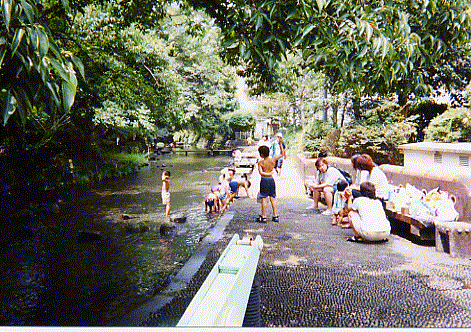 |
| Figure 19 In summer season, children are coming to catch small fishes or crabs alive. |
Sano Museum Keeps Excellent Japanese Swords and Oriental Old Fine Art Objects
In Nakadacho near Mishima Tamachi Station, the second station from the
starting station of Izu Hakone Railway, there is Sano Museum which keeps
many oriental old fine art objects, including Japanese swords, Japanese
paintings, oriental bronze or pottery vessels and so on. Above all its
preserving old art objects, the Japanese swords are the most valuable treasures
made by master hands including Masamune who was called the greatest swordsmith.
His sword in this museum is registered as a national treasure by Minister
of Education.
In Kamakura Era that began about 800 years ago and continued for about
200 years, swordsmiths devised an unique way of making Japanese sword as
the following: They used comaratively soft forged steel as the core of
a sword to prevent from breaking in two by a shock, while using steel of
different solidity as melted material to the parts of both sides and edge.
They heated this long shaped material to deep-red burned steel, hammered
it repeatedly, and folded it more than twenty times with hammering after
every folding, resulting a completed sword consists of more than ten thousand
layers within itself. The Japanese swords were the world strongest and
cut best, in addition to their beautiful shape.
The entrance fee to the museum are \700 for adult and \300 for kid.
The museum has a beautiful excursing Japanese garden called "Ryusen-En"
with a pond of water spring from Mt.Fuji. Neighbouring to the garden, there
is "Sho-In" (which means "The Wind of Pine Trees"),a
restaurant of fine atmosphere in which the waitresses provide customers
with delicious Japanese feasts with reasonable prices.
Yoritomo Took Temporal Sleep under A Pine Tree of Madoromi Jinjya Shrine
prior to His Worship to Mishima Taisha Shrine for Cosecutive 100 Dawns
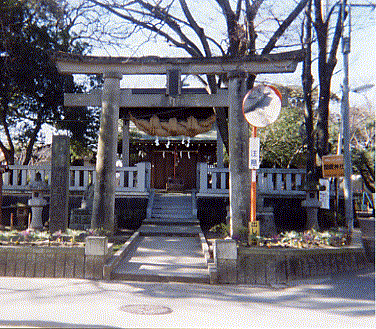 |
| Figure 20 Madoromi Jinjya Shrine which means " temporal sleep." Under a pine tree, Yoritomo took a short sleep before dawn when he came to pray for the restoration of Genji Clan, for 100 consecutive days. |
"Gennari Jizo" Guardian Deity of Child Apotheosizing Kogiku Who Was Killed by A Coldhearted Feudal Lord
On your way to Madoromi Jinjya Shrine, there is a small wooden shrine named "Gennari Jizo" guardian deity of child apotheosizing Kogiku (a little girl's name) who was killed by a coldhearted feudal lord, because Kogiku went across the road to the other side before his parade passing to Yedo City. The sad and pitiful story is as the following:
In Yedo Era, Iyemitsu Tokugawa, Shogunate the third, made all the feudal land lords travel to Edo and to stay there for particular period, say for one year of the coming next three years. while they had to build their own luxurious mansion in which their wife and retainers were living. Since then, successive shoguns had continued to force them this system. It is said that its aim was to make the feudal land lords consume their resources to weaken their military power to prevent from their rebelion. When feudal land lords travelled to Edo City, it took several tens days until they arrive in Edo in the case of from distant lands. In the case of lords who had large domain, they used to make a very long parade by around 3,000 retainers. They forced all the owners of hotels and inns in a town to stop accept travellers in order to stay by themselves, when they pass on their way to Edo. Land lords had to undertake its heavy costs. When their parades are passing, the dwellers of the local villages and towns all had to sit on the ground and make bow to the feudal lord.
One day in 1687, the parade of a land lord whose name was Naoyuki Matsudaira was passing on the road before Mishima Taisha Shrine to Edo. A little lovely girl named Kogiku, a daughter of Gennai Ohariya, who was six years old, suddenly went across the road to the opposite side as her mother accidentally was there. By the regulation in Edo Era, any one who went across a parade of any feudal lord was arrested and punished to death. When Kogiku walked across, a samurai walking the head of the parade pretended that he saw a dog was passing across, thinking to save her little life. But the other retainer arrested her. Surprised people of this place quickly called on a buddhism priest of high rank and requested him to ask for Kogiku's life to the Lord Matsudaira. The priest hurriedly came to there and asked him, however, his effort was fruitless. Kogiku herself asked the lord crying and said, "Please forgive me! I will do anything you say to do." (The term "Gennari" means " I will do anything you say.") Nevertheless, this young coldhearted lord did'nt forgive her and alas she at last was killed. People living in the place pitifully built the small shrine for her near Mishima Taisha Shrine and praied for her.You can see the four small Jizoes stand , watching the small wooden shrine.
A Region of Stillness, Myo Hokkeji Temple in The Suberb of Mishima
If you like to taste a region of stillness of a buddhism temple, you had better get on the bus for Tamasawa in front of the south gate of JR's Mishima Station and get off at the destination. It takes about 30 minutes. You will see old Myo Hokkji Temple there.The origine of this temple was the temple built by Priest Nisshoh, a pupil of Priest Nichiren
(1222-1282) in Kamakura, and was moved here in Edo Era.
In Edo Era, Hidetada Tokugawa, Shogun The Second donated the land of about 150,000 square meters to this temple. The seven buildings here were built by Oman-no- Kata who was the second wife of Iyeyasu, the founder of Tokugawa Shogunate. Oman-no-Kata was
the mother of two sons of Iyeyasu, and was the grand mother of Komon Mito at the same time. Komon is very famous as a wise feudal
land lord who travelled around Japan to see how general public are
living their lives.
In the premises of the temple,there are many old trees of graceful form
having have lived for several hundred years..
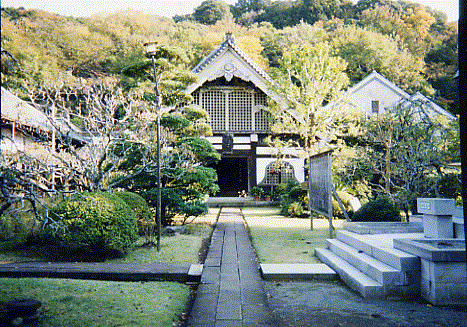 |
Figure 21 The living quarter of Hokkeji Temple. Visitors are accepted here. |
| Figure 22 In the temple, there is a famous long wall.The wall was destroied by a tyhoon several years ago, but in 2001 it was reconstructed like this. |
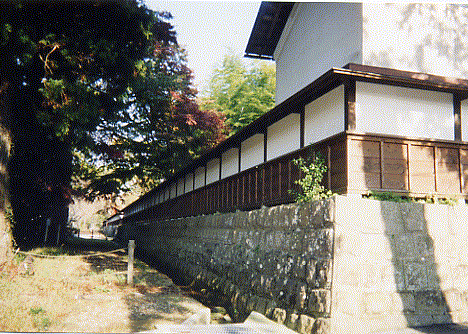 |
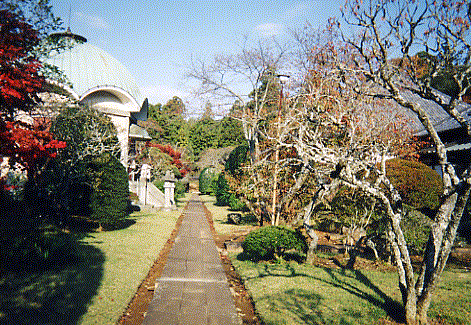 |
Figure 23 The cherry tree at right side was planted by Oman-no-Kata more than 480 years ago. |
Kakitagawa Springs Group Conserves Japan's Richest Clean Water Gushed out of Mt.Fuji
Going down for 1.6 kilo meters the worship roard of Mishima Taishya
Shrine to the south, turning to the right to Numazu City and walking for
1.8 kilo meters, you will see "Kakitagawa Yusui (Spring) Park" on your
left. Kakitagawa Springs Park has Japan's richest clean water springs
group and a dense forest zone. The springs group is selected as one of
"The 100 Natural Beauty" by the central government. The explanation
board by "Kakitagawa Midori-no-Trust Foundation",a volunteer group
explains Kakitagawa as the followimg in short:
"The origine of the springs group is the rains and snows on Mt.Fuji
rising in the sky 40 kilo meters away from Kakitagawa. The rains and
the snows have traveled within Mishima Bottom Stream of Lava which
forms human- blood vessels- like sponged soil for several months to
several tens years. The springs include variety of minerals. The quantity
of the entire group of springs reaches one million tons a day.
The springs, you can see everywhere in the park, form a big river with
1,200 meters in length and flow into Kanogawa River which stretches
to Numazu City on Surugawan Bay. "
Two Hot Spring Places in Mishima City
If you get off the bus to Tamasawa at the stop called "Takekura" on
your way to see Myo Hokkeji Temple, you can visit any one of the
three small hot spring inns whose names are "Minakuchi-So",
"Hakujitsu-So", and "Kinsyo-Kan" to enjoy bathing hot springs.
These steel-brown hot springs including iron mineral are very effective
to your health. The fee of just-bathing is \500 a person.
Another hot spring place is situated in the newly developed residence
area called "Mishima Beauty Town" in the northern district of Mishima
City. In this area there has been a golf link called "Mishima Springs
Country Club". Its owner found the hot spring by balling the ground,
built the annex as bathing facility, and began operation December 2001.
You can arrive at the place near the golf link by getting on the bus to
Mishima Beauty Town. The fee for bathing hot spring are \800 for adult
and \400 for kid for all day long on week day( \600 for adult and \300
for kid after 6 PM) , and \800 for adult and \400 for kid for 3 hours on
Sat., Sun. and holyday.
The two bathing rooms equipped with outdoor bathing tubs are
separated to east and west sides, and for ladies and gentlemen
individually. Customers bathing in the west room and its outdoor tub are
able to look up the most grandeur, elegant Mt.Fuji, and at the same time
able to look down Mishima City, Numazu City, Middle Izu, West Coast of
Izu Penninsula, and Suruga-Wan Bay as a panoramic scene. It is really
fascinating scene. The owner kindly change allocation of the two
bathing rooms every week to ladies and gentlemen, so that both
genders are given equal opportunity.
April 17, 2004 UPDATED
TO PART 1: MISHIMA CITY
TO PART 2: SHUZENJI TOWN
TO PART 3: NIRAYAMA TOWN
TO KAWAGOE CITY
GO TO HAGI CITY
TO PAGE SHOWING CONTENTS
TO CONTENTS IN JAPNESE EDITION
YOUR IMPRESSION
